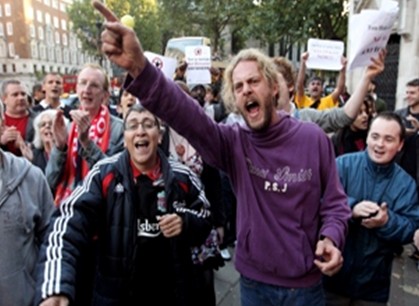发布时间: 2016年10月26日

『负面情绪——愤怒,也有其积极的一面,且看专家们如何证实这一现象。』
The Bright Side of Anger — It Motivates Others
愤怒的另一面
December 15th 2010 | from Time

On the whole, brain scans shore up what we"ve known all along about our emotions: some are positive and some are negative. Happiness, for instance, is positive — when people are in good moods, they tend to show more activity in certain regions on the left side of the brain. Emotions like depression and anxiety are negative, and tend to heighten activity in brain regions on the right.
But what about anger: positive or negative? The answer may not be quite so obvious.
There's a disconnect, for instance, between the psychology literature, which has traditionally labeled anger as a negative emotion.
“There's something unique about anger,” says Henk Aarts, a psychologist at Utrecht University in The Netherlands. “Sometimes it has negative effects, but sometimes it also has some positive feelings that motivate you to do things that you like.”
Some recent studies have touted the positive features of anger, but Aarts and other experimental psychologists at Utrecht University's Goal Lab wanted to investigate further. For their new study, which was recently published in Psychological Science, they presented computer images of various objects like pens and glasses to more than 200 respondents while flashing angry, fearful or expressionless faces in the corners of the screens. Then, to track the effect of these unconscious associations, respondents were asked if they desired the object onscreen. Some were also asked to squeeze a handgrip as hard as they could if they did.
The results showed that respondents tended not to want the objects associated with fearful faces, an expected outcome given the negative nature of this emotion. As for the people subjected to flashes of angry faces, however, they not only tended to want the objects more, but they also squeezed the handgrips harder, suggesting that they were willing to exert effort to acquire the objects.
Perhaps even more surprising are the results of a follow-up study. Using roughly the same study design, the Goal Lab researchers wondered whether flashes of anger would have an effect on the perceived value of the associated objects. Turns out, people are willing to pay more for pens paired with angry faces.
It's not entirely clear why anger motivates such behavior. But Aarts offers an alternative explanation, one that he came up with after reviewing tapes of six-time Tour de France winner Lance Armstrong. “There's a picture of this guy near the finish line and you see anger in his face but you can also see this determination,” he says. “What's interesting is the facial expression of anger almost completely overlaps with the facial expression of determination.”
Further research is necessary, Aarts says, to figure out if the key to motivation lies somewhere between anger and determination. But for now, he stresses that the participants in his study did not experience anger themselves, but that “it was only the perception of anger that we activated.”
Still, the perception of anger appears to be a separate matter. Another study published in the same journal furthers the case for using anger as a motivational tool by demonstrating that team leaders were better at motivating their team to perform by expressing anger — but only if their team members tended to score low on measures of agreeableness to begin with. More agreeable team members responded better to like-minded leaders who expressed happiness.
The implications of these findings are intriguing, to say the least. Imagine the practical applications. Could it be, for instance, that replacing Ronald McDonald's smile with a frown, or hiring angry types as managers would spur some of us to buy more and work harder? Perhaps, but we won't be happy about it.
热门推荐: